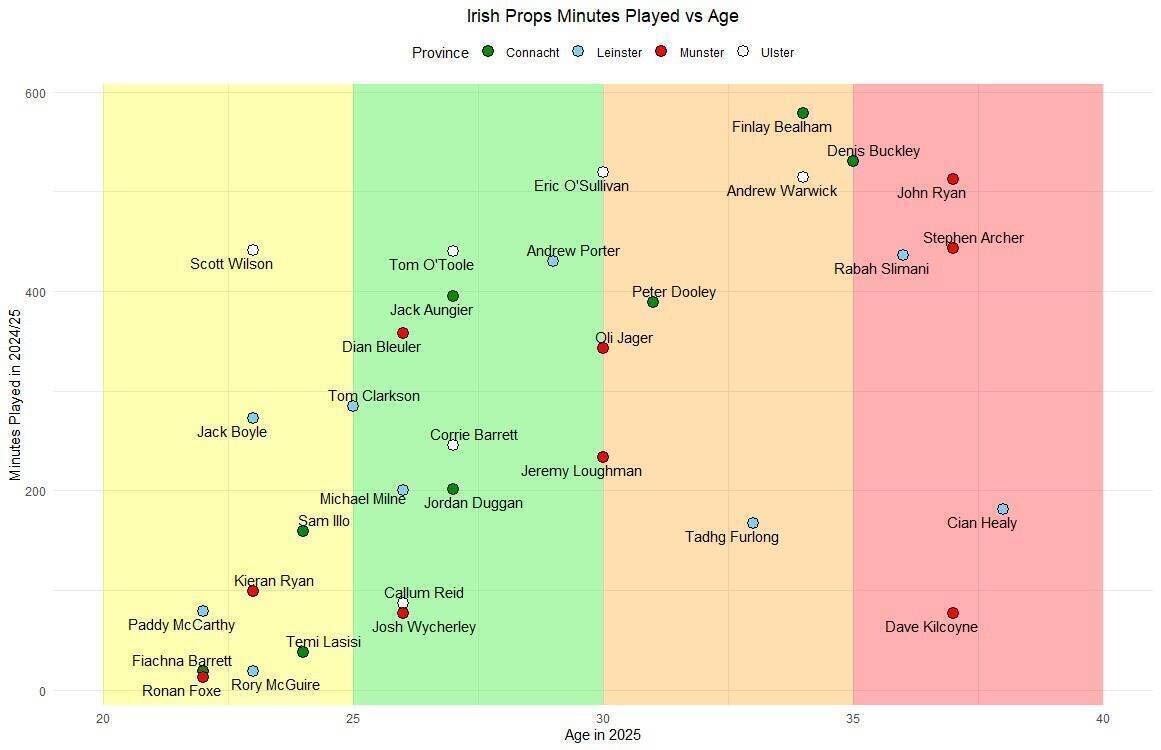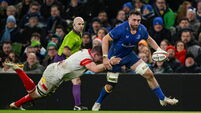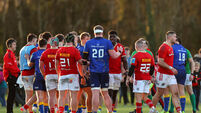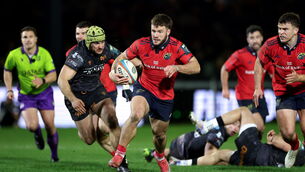What is the solution to the Irish rugby prop problem?

FRONT FOOT: Ireland interim head coach Simon Easterby and Andrew Porter during an Ireland rugby captain's run at the Aviva Stadium on Friday. Pic: Sam Barnes/Sportsfile
The priority has been, is and will continue to be props. Everyone accepts there is a problem. Since the game moved into professionalism Irish rugby has been trying to solve it. Leadership changes but this challenge is constant.
“Since forever, since the game's been professional, there's been questions over how we are going to replace John Hayes,” said new IRFU Performance Director David Humphreys last year as he first pitched a moratorium on the signing of front-rows from abroad.
“The way the Irish system is set up, players come through because we know we can block any foreigners coming into the game.
“I do believe we've got to... it is not about putting pressure on the provinces, but they also need to develop those props.” This is an important point as we consider what the prop problem currently is and where it is headed. Humphreys’ predecessor David Nucifora had greenlit the signing of Frenchman 35-year-old Rabah Slimani just before his departure. It has since emerged Leinster are in discussions about retaining Slimani as well as lock RG Snyman. Humphreys has since conceded that there has to be “flexibility” in their new policy. What was pitched as a hard rule now seemingly exists as a general guideline.
Tom O’Toole’s suspension and Tadhg Furlong’s absence on Saturday has resulted in renewed focus on the tighthead depth chart. This is an age-old tale, from Hayes to Mike Ross and beyond. Both were late developers who benefitted from spells abroad before becoming guaranteed starters in green. Others, like Tom Court, Rodney Ah You, Michael Bent and Finlay Bealham, were born abroad and capped after coming into the Irish system.
On the other side of the scrum, Andrew Porter has become Ireland’s most important international with 37-year-old Cian Healy and 36-year-old Dave Kilcoyne serving as his leading deputies over the last few years.
Fresh cycles always offer a sense of renewal. The Six Nations brings new vibes and new faces. Thomas Clarkson’s exciting progression will take another step forward as he is set to add to his two appearances in the Autumn Internationals. There is a need for the Wicklow native to be more than a suitable back-up, Ireland need this to be a template.
The former U20 Grand Slam winner has played a moderate 285 minutes this season including three starts. The only prop who is younger and has played more minutes is Ulster’s Scott Wilson.

While injuries have impacted Furlong, Healy and Dave Kilcoyne, the majority of players with the least minutes played are young prospects. Connacht, Munster and Ulster have rolled out their established Irish front rows for extensive gametime as they desperately fight for positive results.
Does Clarkson need more exposure? That depends on whom you ask. Leinster’s most used prop this year is Slimani. Leo Cullen was recently adamant that the insistence on game time to develop talent is ‘nonsense’. Slimani is happy to help Clarkson in a way Irish international sometimes are not. Plus, Cullen suggested, Slimani won’t ‘disappear’ during international windows.
In hindsight all of this was a not-so-subtle case for Leinster to be granted permission to retain the prop. The fact that Slimani was soon after recalled to the France Six Nations squad for the first time since 2019 was unfortunate in that regard.
Then there is the reality of Irish pathways. At schoolboy level, there is a limit on how far a team can push in the scrum. That suits mobile props; however, it can also make the transition to the professional ranks harder. Ireland national scrum coach John Fogarty is actively striving to bridge this gap. There was confirmation this month of a superb appointment in Seamus Toomey as Performance Pathway Scrum Coach.
Load management is often hailed as a virtue of the Irish model, but limited opportunities will force players and coaches to innovate. John Hayes started out as a second row. A stint in New Zealand forged his front row credentials. Where did he learn the most? In games. His first run-out was actually as a loosehead for Marist against Woodlands. “He absolutely mangled me,” Hayes wrote in his autobiography, The Bull.
“I couldn’t keep him out because I didn’t know how, and the muscles in my neck weren’t strong enough anyway. I was gone out, he was gone in, so now they had a three-on-two in the front row when it should have been three-on-three.
“And that has a domino effect on the rest of the scrum. That was the night my real education in the front row began. But I’d say there were easier ways to learn. I was thrown in at the deep end that night and nearly sank without trace.”
Mike Ross accepted his rugby education was, ‘brief. Maybe even primitive.’ He went from the club game to Harlequins. Out of the sandbox into the fire, where he was forged.
“I’m not going to be shy about saying this, but there was absolutely no doubt that I was one of the very best scrummagers in the All-Ireland league,” he said in Dark Arts.
“But the professional game is a whole different place to be. It’s post-amateur, post apocalypse if you like. It’s a place where you can feel amazingly well loved. It’s a place where you can feel utter desolation and find yourself totally alone. It’s every man for himself.”
Since the 2023 World Cup, Andy Farrell’s outfit has dealt with Furlong’s fitness issues impressively.

Andrew Porter’s value for Ireland was clear in 2024 as he started all 11 tests. Tom O’Toole’s versatility saw him operate on both sides.

There are many ways to make a player. On Saturday at the Aviva Stadium, England’s replacement props are 22-year-old Fin Baxter and 25-year-old Joe Heyes. Both have made more club appearances than Clarkson for Harlequins and Leicester respectively.
Clarkson has come through Leinster Schools and AIL. Since signing a pro contract in 2021, has had the benefit of quality coaching in an elite environment with a couple of deliberate big-game opportunities. Leinster and Ireland need that to be enough.












